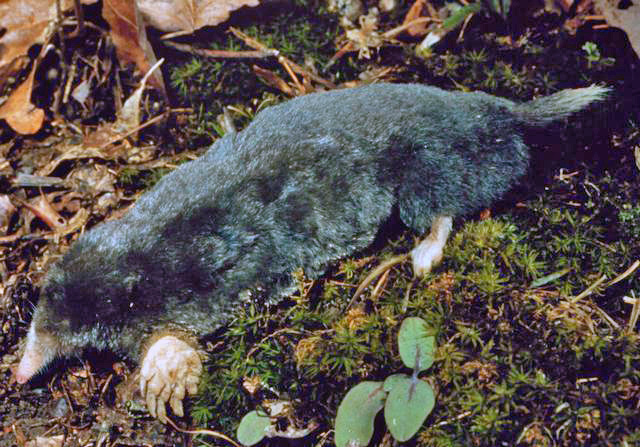Hairy-tailed moles may be active at any hour, and during all seasons. These moles construct both surface tunnels and deep tunnels. Temporary, or feeding, tunnels are constructed barely beneath the surface by the mole during its search for food. Deeper tunnels, constitute the mole's living quarters, and serve as a retreat during dry or cold weather, are located from 25 to 45 cm beneath the surface. Foods include earthworms and various insects, especially beetles.
Species Measurements:
- Adult Total Length: 135-175 mm (5 1/2-7 in.)
- Tail: 25-38 mm (1-1 1/2 in.)
- Hind Foot: 17-22 mm (3/4 in.)
- Weight: 40-65 g (1 1/5-2 1/4 oz.)
Physical Characteristics:
Moles have soft, silky, dense fur that lies equally well when brushed either forward or backward, an adaptation to facilitate movement in either direction in the underground burrow. The short front limbs possess feet that are greatly enlarged for digging. The forefeet are at least as broad as they are long, and the palms face outward. The claws on the forefeet are broad and flat, while those of the hind feet are relatively short and weak. The tiny, degenerate eyes are concealed in the fur, and are covered by fused eyelids. External ears are absent. The robust hairy-tailed mole has shiny, black fur and a short, hairy tail. The nostrils are lateral and crescent-shaped. It is the smallest of the park's moles.
Habitat:
Moles are highly specialized for subterranean life. The hairy-tailed mole prefers well-drained areas with sandy loam soil, and a good cover of vegetation. Specimens collected along Chapman Prong and Buck Fork under damp rocks in rhododendron thickets represented the first record of this species in Tennessee (Komarek and Komarek, 1938).
Reproduction:
Mating usually occurs in late March or early April, with a litter of four or five young being born after a gestation of approximately four to six weeks (Hallett, 1999). Weaning occurs at about 3 to 4 weeks of age.
Longevity:
The maximum life span is about 4 years.
Terrestrial Ecology:
Hairy-tailed moles may be active at any hour and during all seasons. These moles construct both surface tunnels and deep tunnels. Temporary, or feeding, tunnels are constructed barely beneath the surface, but at a uniform depth. These tunnels are built by the mole during its search for food. The deeper tunnels are located from 25 to 45 cm beneath the surface. These lower tunnels constitute the mole's living quarters, and serve as a retreat during dry or cold weather. A large chamber in the deeper runways serves as a retreat, and as a nest site for the young.
Feeding Habits:
Foods include earthworms and various insects, especially beetles.
Predators and Defense:
Predators include foxes, owls, and snakes. A hairy-tailed mole found dead on the road between Newfound Gap and Indian Gap had apparently been killed by a fox, because fox scats were found beside the animal (Pfitzer, 1950).
Parasites:
"Porcupine Flea", Ctenophthalmus pseudagyrtes Baker
The hairy-tailed mole ranges from southern Quebec and Ontario, south through the New England states to central Ohio, eastern Tennessee, and western North Carolina.
The hairy-tailed mole has been found at elevations ranging from 1,480 feet (park headquarters) to 6,400 feet (Clingmans Dome).
References:
Hallett, J.G. 1999. Hairy-tailed Mole. Pages 62-63. In: Wilson, D.E. and S. Ruff (editors). The Smithsonian Book of North American Mammals. Smithsonian Institution Press, Washington, D.C.
Komarek, E.V. and R. Komarek. 1938. Mammals of the Great Smoky Mountains. Bulletin of the Chicago Academy of Science 5(6): 137-62.
Linzey, D.W. 1995a. Mammals of Great Smoky Mountains National Park. The McDonald & Woodward Publishing Company, Inc., Blacksburg, Virginia.
Linzey, D.W. 1995b. Mammals of Great Smoky Mountains National Park-1995 Update. Journal of the Elisha Mitchell Scientific Society 111(1): 1-81.
Pfitzer, D.W. 1950. Report on Mammals Collected or Observed, June-October, 1950. (Typewritten copy in files of Great Smoky Mountains National Park).

